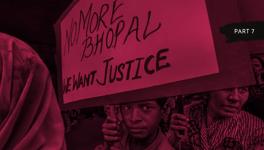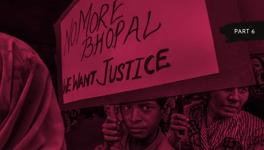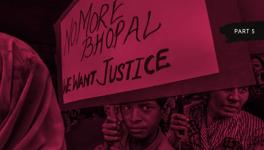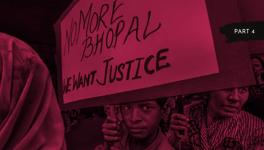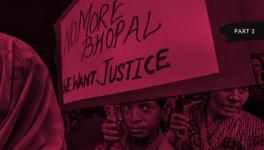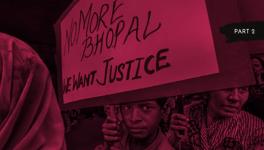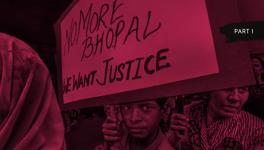Why Are Bhopal Gas Tragedy's Lessons Not Part of Constitutional Ethos?
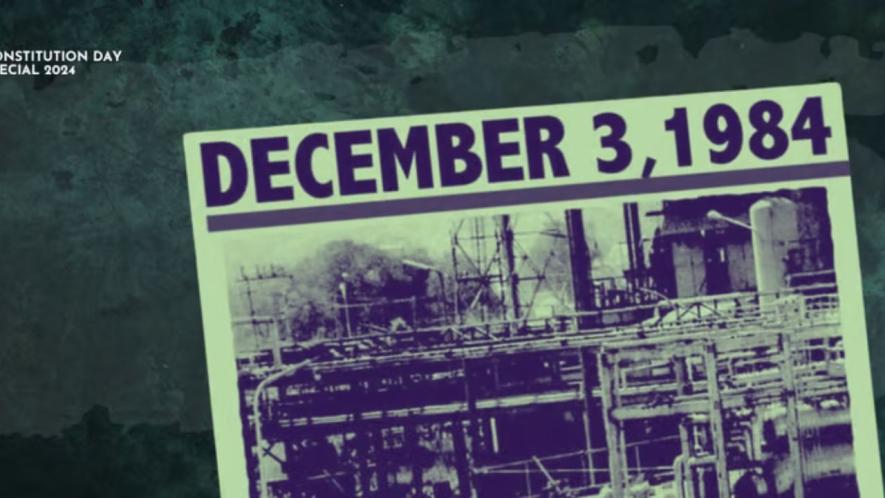
This Constitution Day, how do we reflect on the world’s worst industrial disaster in Union Carbide, Bhopal as we approach the 40th anniversary of this carnage? It is a tragedy every Indian is familiar with, but over the years it has been reduced to a footnote in public memory, ruefully remembered by most people just once a year when the anniversary approaches.
In the meantime, untold suffering, trauma and harm people were subjected to continue to haunt them and future generations bear the harsh impact in the form of disabilities, mutagenic disorders, reproductive wrongs, cancer and mental health issues even four decades after the tragedy.
Successive governments have not created any substantial policy changes to address, prevent or prepare for such disasters in the future, and there is still no law on corporate accountability in case of such accidents. With the new buzz around ‘ease of doing business’, accountability has been eroded further.
The same industries continue to be encouraged and there is no promise of non-repetition. In these four decades, we have witnessed malicious attempts by Union Carbide and the State to deny culpability by deliberately misconstruing the harm, passing the buck and squabbling over the number of dead and the affected.
With the new buzz around ‘ease of doing business’, accountability has been eroded further.
The tragedy and its lessons
What are the lessons for the movements for justice that the 1984 disaster offers and how do we read Bhopal 40 years later?
U.S. multinational Union Carbide and its Indian subsidiary, Union Carbide India Limited (UCIL) started setting up the Bhopal factory in the late sixties and by the 1970s, began dealing in a chemical pesticide, Sevin.
The 1960s was a time when India’s so-called Green Revolution was ushered in Punjab, Haryana and Western Uttar Pradesh. Pesticides were the key ingredients, along with chemical fertilisers, for the new high-yielding variety seeds that were pushed through institutional support in these states.
Green Revolution, the package of high-yielding seeds of rice and wheat, networks of irrigation and heavy groundwater usage, dependence on chemical pesticides and fertilisers, and broad institutional support had raised new hopes for food self-sufficiency, and hunger and malnutrition mitigation in India.
Today, there are a million reasons to question the so-called Green Revolution’s promise (which it failed to deliver). It was environmentally unsustainable, the indiscriminate use of groundwater it encouraged took a toll on human health through heavy metal poisoning and the monocropping accelerated a heavy onslaught of pests causing major crop loss, bankruptcies and suicides.
But back in the 1960s, the hegemony of science and the technology package offered under the Green Revolution was unquestioned. Even the sceptics maintained that ecologically destructive methods may be detestable but are necessary to increase farm production.
Ignoring the evidence that indigenous methods are capable of similar or higher yields, agriculture under the Green Revolution technology package was made heavily dependent on chemical fertilisers and pesticides.
What are the lessons for the movements for justice that the 1984 disaster offers and how do we read Bhopal 40 years later?
When it entered the fray, Union Carbide was voraciously targeting precisely the market that the dependence on that technology package had opened. The Indian pesticide market was estimated to be one of the largest in the world— nearly 40 percent of the area under cultivation had already been brought under high-yielding varieties. The demand for pesticides was only going to grow.
The manufacturing process of Sevin required some lethal chemicals such as methyl isocyanate (MIC), a volatile chemical that the carbide factory initially imported. To enhance profits by eliminating international shipping costs and taking advantage of lower labour costs in India, the company proposed to manufacture and store MIC at the plant.
The government also pushed local manufacturing to reduce imports and protect foreign exchange. So even when the climatic conditions for its storage were not favorable, the production process was initiated.
It is well documented that from the beginning there were shortcuts in safety procedures. Union Carbide built the factory in a densely populated urban area and the storage of large quantities of methyl isocyanate overlooked the risk factors.
The maintenance costs were routinely cut, some systems did not work and other systems were often turned off to make small savings in electricity costs. The workers’ union— Union Carbide Karamchari Sangh— formed in the early 1980s, consistently warned the local population and the workers of the occupational hazards.
But all forewarnings were ignored and the State demonstrated complete indifference. The inspection of the factory was consistently inadequate; just a few weeks before the gas leak, the Union Carbide factory was granted an environmental clearance certificate by the state pollution control board.
On the night of December 2–3, 1984, a large amount of MIC escaped from a storage tank and the poisonous gases quickly spread, affecting around 36 of the 56 Bhopal municipal wards. It is estimated that the disaster claimed the lives of over 2,000 the same night and 20,000 died over the following years. Severe injuries were caused to approximately 550,000 others— this was over 60 per cent of the city’s population.
Four days after the disaster, Warren Anderson, the then chairman and chief executive officer (CEO) of Union Carbide Corporation, appeared in Bhopal and was arrested immediately. But he was let off within hours of his arrest, allegedly on the orders of some senior political leader in Delhi.
He managed to escape, allegedly under the safe passage of a few officials and politicians. As the criminal cases proceeded against Union Carbide, Anderson’s extradition was sought but it was rejected by Washington in 1992. Another 2011 Indian government request for extradition remained pending. Anderson died in September 2014, a few months before the 30th anniversary of the disaster, without facing a trial.
Ignoring the evidence that indigenous methods are capable of similar or higher yields, agriculture under the Green Revolution technology package was made heavily dependent on chemical fertilisers and pesticides.
In March 1985, the government of India passed the Bhopal Gas Leak Disaster (Processing of Claims) Act, which granted it the exclusive authority to represent the victims of the disaster in civil litigation against Union Carbide.
In 1989, the government of India reached a settlement with Union Carbide— one made without the consultation or consent of the survivors themselves— whereby the US multinational agreed to pay US $470 million to the government of India.
Holding no accountability to the victims, the compensation was paid to the government but not to the victims directly. In exchange for the payment, Union Carbide was absolved of all civil liabilities, including all claims by Indian citizens, corporations, partnerships or other entities arising connected with the Bhopal gas leak disaster against the multinational and its subsidiaries and affiliates. All criminal proceedings were also extinguished.
The families of the victims of the carnage received compensation of ₹1 lakh for every death and ₹25,000 for lifelong injuries. The Indian government shamefully signed on to this settlement and also agreed to defend the corporation in the event of any future lawsuits. The Bhopal victims’ compensation case was sealed with this settlement.
Over the years, several individual survivors tried to file lawsuits against Union Carbide (which became part of Dow Chemical in 2001) in the United States. However, these lawsuits were dismissed, with the recommendation to pursue claims through the Indian legal system instead. In most cases, they were dismissed because the court found that these claims were barred by the 1989 Union Carbide settlement in India.
Forty years later, the victims and survivors of Bhopal remain without justice and continue to wage a struggle without much support. The victims endured the harmful impact of the poisonous gas, and the impacts are being passed down genetically.
To date, the State and the corporation have not been held to account. Union Carbide, Warren Anderson and Dow Chemical never stood trial. The state government created a Department of Bhopal Gas Tragedy Relief and Rehabilitation in 1985. It outlined a medical rehabilitation programme spanning several years, widows were given a pension of ₹200 per month, and in 1992 a housing colony called the Gas Vidhwa (Gas widows) Colony with 2,486 units was built to provide housing for the widows of 1984. This is as far as the compensation goes.
Union Carbide built the factory in a densely populated urban area and the storage of large quantities of methyl isocyanate overlooked the risk factors.
The vast area around the Union Carbide factory lay ravaged by the remnants of the killer factory. Union Carbide shut down the site and left it to rust. It has never been cleaned up. But the people have not given up their fight, they are archiving cruelties, they are keeping records and moving to local courts to fight for their rights, and fix liabilities against grave criminal negligence heaped on them.
They built local and national support groups and found international allies in their fight. Bhopal Gas Peedith Mahila Udyog Sangathan (BGPMUS), the Bhopal Gas Peedith Sangharsh Sahayog Samiti (BGPSSS) and several others remain steadfast in their resolve and continue to voice protest at various forums to not let the pain be suppressed.
Their undying campaigns remain a thorn in the side of the Indian State and the responsible corporations, Union Carbide and Dow Chemicals. It remains an inspiration for people all over the world.
Never again?
Fast forwarding to the summer of 2022 to Mansurwal in Punjab, the land of Green Revolution— poisoned and contaminated by pesticides like Sevin. On the body politic of rural Punjab, the seeds of the Green Revolution are now festering wounds breaking out in the form of landlessness, escalating costs of farming, mounting farm debts, suicides, ecological crisis manifesting in the degradation of the environment, contaminated water, illnesses, lack of employment and the increasing hold of corporate giants on the lives of farmers.
The burden of disease and death has been mounting but no government is ready to commission even a white paper to look at its links with environmental degradation caused by pesticides, fertilizers and groundwater pollution.
In the early summer of 2022, the farmers had barely returned from the Delhi borders after a 13-month protest on the borders of Delhi when they had to return to occupy the road to the Malbros factory in Mansurwal village in Zira tehsil, Ferozepur, in Punjab.
Just a few weeks before the gas leak, the Union Carbide factory was granted an environmental clearance certificate by the state pollution control board.
Malbros is an alcohol manufacturing plant established in 2006 as a distillery but it was redeveloped as an ethanol unit in 2014. In what has come to be known as Zira Morcha, hundreds of villagers sat on dharna in front of the Malbros factory demanding the plant be shut down permanently as it was polluting groundwater in several villages besides causing air pollution and affecting the soil.
They claimed that to cut costs for proper disposal of the waste, the factory was indulging in reverse boring, discharging toxic effluent back into the soil turning the soil infertile and polluting the groundwater with the result that people in scores of adjoining villages could not drink the water drawn from their borewells.
The people and the cattle in the area have been dying or severely affected by diseases such as cancer, endocrine gland genetic disorders, deformity in newborns, infertility and diabetes, which were unknown in the area a decade ago, the villagers alleged.
Once these pollutants enter the groundwater, they come out through hand pumps and tubewells. Local villagers had been approaching the concerned authorities to alert them of their cattle dying in droves but to no effect. Many concerned scientists also suggested that specific tests be done to rule out the presence of harmful chemicals. All requests fell on deaf ears.
Protests began on 24 July, 2022 when an alcohol-like stench emanated from a 650 feet borewell, dug in the Gurudwara compound of a neighbouring village. Angry farmers protested and sat on a dharna occupying the road and not allowing the factory owners or the employees to enter the premises.
The factory’s owner— an influential liquor manufacturer and former member of legislative assembly (MLA) from the area— approached the Punjab and Haryana High Court to make his establishment functional.
He argued that the water, soil and air were contaminated not because of the factory waste, but of the chemical fertilisers and pesticides that the farmers used with impunity.
Without going into the complaints of the farmers about the debilitating effects on the groundwater, soil and quality of life as one of the main reasons for the spread of the lethal disease, and the factory’s responsibility for the environmental degradation and its consequences in the area, in a series of Orders, the high court asked the Punjab government to ensure the protest was shifted at least 300 meters away from the factory’s gate so that it could start work.
Forty years later, the victims and survivors of Bhopal remain without justice and continue to wage a struggle without much support.
The state government deployed police to forcibly eject the protesters. However, no amount of police violence and repression could break the will of the protesters. The deadline given to the state came and went but the farmers refused to vacate the dharna.
Malbros knocked on the doors of the high court again. In its Order, the judge asked the state government to deposit ₹20 crore with the high court registry as possible compensation to the factory owner, who claimed losses of crores due to farmers.
The state government promptly followed the Order and deposited the money under pressure from industry. The court also asked the government to list the details of the protesters and their properties so that their assets could be attached to compensate the factory owner. Once again, the State machinery was in action going into the villages intimidating the protesters and families and gathering their property details. But they failed to browbeat the farmers.
As they sat there, in what was deeply moving, the women and men in the area articulated their problems with clarity. Their narratives were filled with a sincere desire to negotiate a better future for themselves and their children. Their conversations were filled with stories about daily challenges of quality of life lowered by the factory, poor health, death, disease and unemployment.
They recognised that their health and the environmental risks they faced were not isolated issues; instead, they were interconnected with the political economy and the policy choices.
Their accounts of pollution encompassed both the tangible experience of environmental degradation and the complex social and political dynamics between the industry and the community— how their lands were acquired by selling the dreams of greater opportunities for the next generation.
They spoke of the deeply rooted imbalances in the relationship between rural residents and the alcohol factory hindering efforts to reverse the damage inflicted upon the environment and the social fabric of the community.
Farmers were not unclear; they sought a different type of industry; a more just and inclusive development and they demanded accountability for the harm they have been enduring.
Drawing on their experiences, the farmers put forward proposals that aimed to open up ongoing avenues for negotiation and reimagine the role of the industry in their lives. Farmers were not unclear; they sought a different type of industry; a more just and inclusive development and they demanded accountability for the harm they have been enduring.
The powerful struggle created pressure on the institutions responsible for undertaking environmental audits to conduct soil, water and pollution tests.
Under force, samples of water and soil were drawn from the factory and nearby areas. The sampling was done by the Central Pollution Control Board (CPCB), the National Green Tribunal, and a high court-constituted committee monitored the results.
The results confirmed the worst fears of the local people. The CPCB report mentioned that it suspected that the liquor factory was involved in injecting contaminated water into the ground through reverse boring.
It found the water samples drawn from 29 borewells near the liquor factory unit to be unfit for drinking. In one borewell, they found cyanide four times the permissible limit. The findings formed part of a report that CPCB submitted before the National Green Tribunal.
Under pressure from protesting farmers who were monitoring the test reports, the integrity of the evidence was upheld. On January 18, 2023, the Punjab chief minister announced the closure of the Zira liquor factory. By then the protest had completed 177 days at the site.
The protesters have not stopped their fight, they are now seeking compensation for deaths, diseases and permanent disabilities linked to the devastation caused by the factory; there is also a proposal to turn the sealed factory into a memorial as an acknowledgment of the harm it has done. It is a long-drawn battle but the farmers and villagers are putting up a spirited fight.
It is our good fortune that nothing on the scale of Bhopal has happened again but Malbros and many other similar plants show a continuity, and the spectre of 1984 Bhopal continues to loom large.
It is our good fortune that nothing on the scale of Bhopal has happened again but Malbros and many other similar plants show a continuity, and the spectre of 1984 Bhopal continues to loom large.
History tells us that nations rethink and course correct after disasters but there has not been any such conversation in India. As ‘production over safety and profit over everything’ continues to be the bedrock of corporate decision-making and the State continues to sit in defence of capital, offering Indian soil for exploitation by corporations using global labour arbitrage, the spectre of death and disease is always looming overhead.
The more we lower our labour standards, the more vulnerable we make our people, and the higher the attraction for global capital to come to India.
Union Carbide is an untold tragedy, but many more are waiting in this race to the bottom if they are not resisted. The 40th anniversary is perhaps already too late to start a conversation about a different future that ensures justice for the people harmed by the development process. But start we must because the collective struggles show governments and corporations are invincible until they are not!
Get the latest reports & analysis with people's perspective on Protests, movements & deep analytical videos, discussions of the current affairs in your Telegram app. Subscribe to NewsClick's Telegram channel & get Real-Time updates on stories, as they get published on our website.









